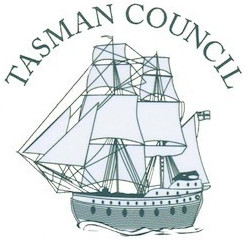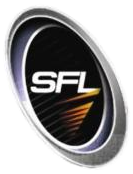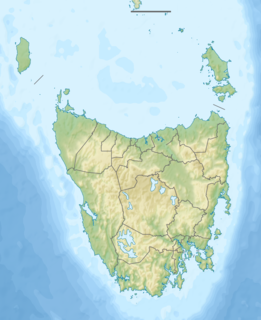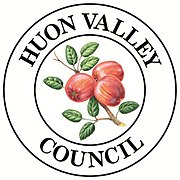
Glenorchy is a suburb of Hobart, in the state of Tasmania, Australia. Glenorchy is bound by the River Derwent to the east, Mount Wellington to the west, Hobart City to the south and Brighton to the north. The city officially begins at Creek Road Newtown, in Hobart's northern suburbs, and includes, Moonah, Derwent Park, Lutana, Goodwood, Chigwell, Claremont and Austins ferry. It is the seat of the local government area of the same name, the City of Glenorchy.

The Tasmanian Legislative Council is the upper house of the Parliament of Tasmania in Australia. It is one of the two chambers of the Parliament, the other being the House of Assembly. Both houses sit in Parliament House in the state capital, Hobart. Members of the Legislative Council are often referred to as MLCs.

Tasman Council is a local government body in Tasmania, situated in the south-east of the state. Tasman is classified as a rural local government area and has a population of 2,372, the region covers both the Tasman and Forestier peninsulas, with Nubeena the principal town.

Break O'Day Council is a local government body in Tasmania, situated in the northern part of the state's east coast. Break O'Day is classified as a rural local government area and has a population of 6,104, the major towns of the region include St Helens, St Marys and Scamander.

Huonville is a town on the Huon River, in the south-east of Tasmania, Australia. It is the seat of the Huon Valley Council area and lies 38 km south of Hobart on the Huon Highway. At the 2016 census, Huonville had a population of 2,714 and at the 2011 census had a population of 1,741.

Glenorchy City Council is a local government body in Tasmania, and one of the five municipalities that constitutes the Greater Hobart Area. The Glenorchy local government area has a population of 46,253, covering the suburbs north of central Hobart on the western shore of the Derwent River, including its namesake suburb, Glenorchy.

The Huon River is a perennial river located in the south-west and south-east regions of Tasmania, Australia. At 174 kilometres (108 mi) in length, the Huon River is the fifth-longest in the state, with its course flowing east through the fertile Huon Valley and emptying into the D'Entrecasteaux Channel, before flowing into the Tasman Sea.

The Southern Football League is an Australian rules football league based in Tasmania, Australia.

The Electoral division of Huon is one of the 15 electoral divisions in the Tasmanian Legislative Council. It was created in 1999, however similar electorates of this name have existed since 1900, and members of the Tasmanian upper house for this region appear to have been elected since 1856.

The Huon Valley, or simply the Huon is a valley and geographic area located in southern Tasmania, Australia. The largest town is Huonville, with other smaller towns spread across the area. It includes Australia's most southern permanent settlement at Southport. The Huon Valley Council area had a population of 15,140 in 2011. Famed for its apple growing, the Valley was first settled by British colonists in the 1820s; prior to settlement the Huon Valley area was inhabited by the Palawa people.

Launceston City Council is a local government body in Tasmania, located in the city and surrounds of Launceston in the north of the state. The Launceston local government area is classified as urban and has a population of 65,274, which also encompasses the localities including Lilydale, Targa and through to Swan Bay on the eastern side of the Tamar River.
The electoral district of Kingborough was an electoral district of the Tasmanian House of Assembly. It was based in the region to the immediate south of Tasmania's capital city, Hobart, and included the Huon Valley towns of Cygnet, Huonville, Kettering, Margate and Sandfly.
Adriana Johanna Taylor is an Australian politician. She was an Independent member of the Tasmanian Legislative Council for Elwick from 2010 to 2016.
Grove is a suburb in the Huon Valley Council local government area in Tasmania, Australia. The suburb has a postcode of 7109.

The Weld Valley, located in southern Tasmania, is an area of aboriginal cultural heritage and natural history within the Tasmanian Wilderness World Heritage Area. The valley stretches north-west of Huonville and is approximately 50 kilometres (31 mi) west of Hobart.
Periodic elections for the Tasmanian Legislative Council were held on 1 May 2010. The two seats up for election were Apsley, held by independent MLC Tania Rattray-Wagner, and Elwick, held by retiring Labor-turned-independent MLC Terry Martin. These seats were last contested in 2004.

Ranelagh is a township in the Huon Valley of Tasmania, Australia. A satellite town of Huonville, which it is adjacent to, it is a former agricultural area and now a tourist town and residence for workers who commute to other areas for work. At the 2011 census, Ranelagh had 1,027 people.

Henry Hunter (1832–1892) was a prominent architect and civil servant in Tasmania and Queensland, Australia. He is best known for his work on churches. During his life was also at various times a state magistrate of Tasmania, a member of the Tasmanian State Board of Education, the Hobart Board of Health, a Commissioner for the New Norfolk Insane Asylum and President of the Queensland Institute of Architects.
Robert Henry Armstrong is an Australian politician. He was elected to the Tasmanian Legislative Council on 3 May 2014 as the independent member for Huon, defeating high-profile Liberal opponent Peter Hodgman. Prior to his election he served as mayor of Huon Valley Council for 13 years.


















